Best eats: Revisiting Syed Alwi Road for big, bouncy Hakka beef balls
GOLD 905 DJ and Makan Kakis foodie Denise Tan returns to Gar Lok Eating House for another authentic Hakka dish – beefy broth and springy meatballs courtesy of The Beef House.
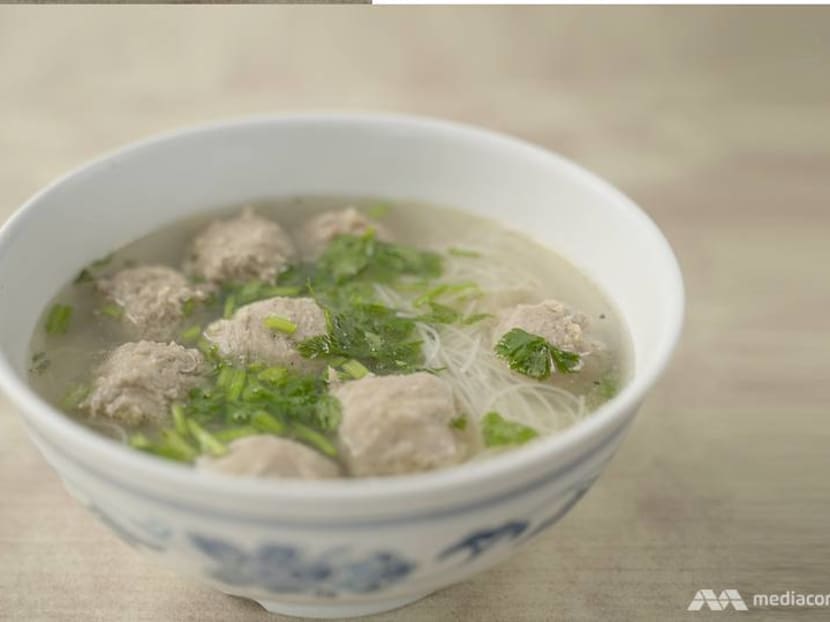
The Beef House, which serves delicious Hakka beef balls, is run by the same family that serves up authentic Hakka yong tau foo at a nearby stall. (Photo: Abundant Productions)
Generally, unless it’s homemade, I find beef balls sold frozen at supermarkets or served at most hawker stalls unsatisfactorily small and unpleasantly floury, filled with more binder than real meat.
Then I discovered The Beef House’s Hakka beef balls, recommended by my Makan Kaki, Lyn Lee of Awfully Chocolate and Sinpopo Brand.
The family behind said beef balls might sound familiar, especially if you recall their handmade yong tau foo I introduced in an earlier story. Noting the steady stream of customers at their sister stall, I just had to return to the always busy Gar Lok Eating House for a taste of their Hakka beef balls.
Mr Chia Teck Kwang, who had previously made me a delightful yong tau foo and noodle meal, was there at the coffeeshop on Syed Alwi Road, dividing his time between the yong tau foo and beef ball stalls. Things are especially hectic from 8am till 1pm, so he had me speak to his niece-in-law, Mrs Brenda Chin, whose camera-shy husband (“everybody calls him Chin”) is the son of Mr Chia’s sister.
Chin is the man in charge of beef ball production and the supplier of the distinctive beef balls Mr Chia has been serving up with noodles and in soup for the last 20 years. Since Gar Lok Eating House became their new home in 2000, Chin has been making beef balls and Mr Chia has been cooking them for their growing customer base.
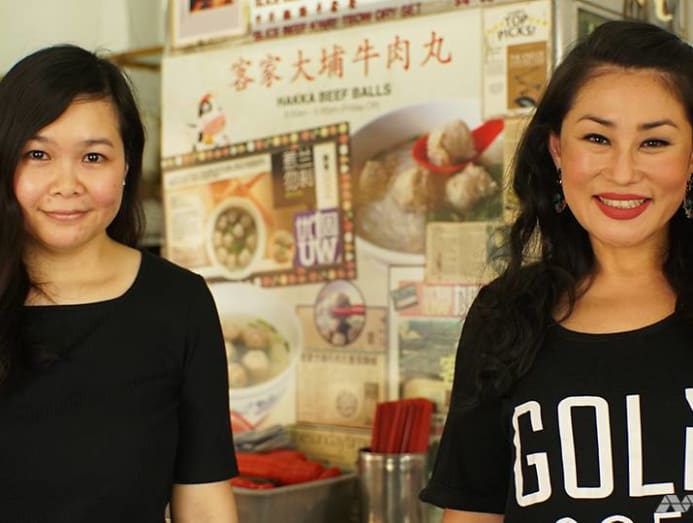
Brenda, who herself comes from an F&B family (her grandfather used to sell soybean milk at nearby Sungei Road), revealed: “My husband has a 3am start every day. He waits for the cartons of Australian beef to arrive in the morning, then beef ball production begins.”
Most of the fat is removed from the beef, which is then minced, seasoned and mixed according to an old family recipe. In fact, Chin and his father even travelled back to China to re-learn the art of making beef balls the time-honoured Hakka way.
“The beef balls come from my husband’s side (of the family),” Brenda continued. “His Hakka grandfather first brought the recipe to Singapore from Dapu, China. Everything back then was handmade. Raw meat had to be pounded with wooden sticks and softened for two hours. And then the beef balls were shaped by hand. But in 1979, the cattle farms in Singapore closed down so it was harder to get fresh meat and make everything by hand, so we had to design our own machine.”
READ: Best eats: There's authentic, handmade Hakka yong tau foo in the Little India area
The family-designed beef ball machine is now 30 years old and still running like a dream, transforming 50 kilograms of fresh, raw meat into the 2,500 beef balls sold daily.
Two types are served at The Beef House: Regular beef balls and beef tendon balls. For the beef balls, fats, veins and other detritus other than pure meat are removed before being minced and mixed in the machine along with secret seasonings, until the perfect texture is achieved. The resulting beef mixture is almost paste-like, with a smooth and sticky consistency.
Meanwhile, the beef tendon balls are produced in much the same way, except the tendons, veins and other cartilaginous bits are left in the beef before being run through the same machine.
Brenda informed me that the once labour- and time-intensive process has been shaved down to mere seconds with their machine, compared to the two hours that it used to take. While the machine can also form the meat mixture into balls, they split the duties, still choosing to scoop and shape their beef balls by hand as far as possible.
This is done with one hand grabbing a handful of meat mixture, scraping off a rounded portion of it on to a Chinese spoon, which then conveys the little globe of meat to a waiting tub of water. The resulting beef ball is a little more irregular in shape than if it was machine-formed. But in terms of taste and texture, Brenda assured me that there was no difference.
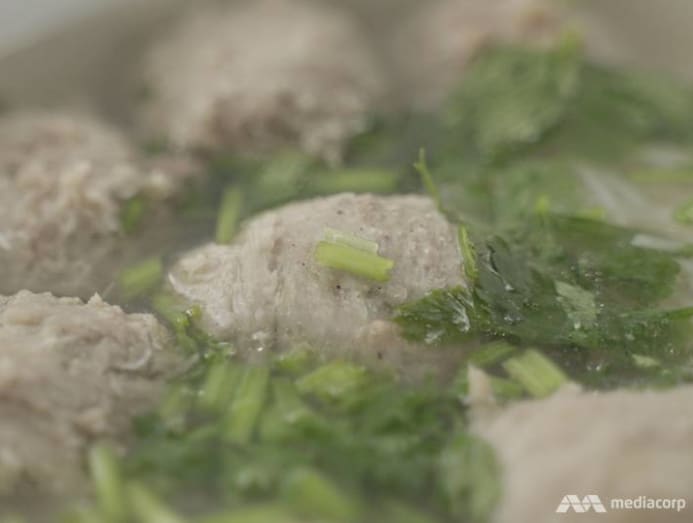
When all the beef balls are shaped, they are par boiled, then frozen for two days. That last step took me by surprise until Brenda explained their little secret. “We can’t just cook and serve immediately. To make sure they are bouncy, we freeze them first.”
Speaking of which, customers often order 1 kg bags of frozen beef balls to take away, especially during festive seasons like Chinese New Year. Brenda added: “That’s why we often sell out so quickly. Our beef balls are tasty, traditional and we use only lean meat, so they’re healthy and nutritious. You can’t find this kind of beef balls elsewhere. Ours are made from 99 per cent beef and only one per cent cornstarch.”
READ: Best eats: Famous Little India chapati and keema has a second branch
She had me at one per cent. Hardly any fillers or binders? Nearly 100 per cent pure beefy goodness? I immediately ordered up a simple and soothing bowl of mixed beef balls in bee hoon soup (S$4 or S$5), which Mr Chia prepared pronto. I was presented with the very picture of wholesome purity – a beautiful bowl of rice vermicelli and eight mixed beef balls in a light broth, finished with a puff of white pepper powder and garnish of cilantro and spring onion.
I started with the beef tendon balls, which were more uneven on the surface and a little rough around the edges, thanks to tiny, tasty nubs of collagen-y tendon. These scrumptious spheres of beef had a crunchier, chewier texture than the regular beef balls, which reminded me almost of good quality frankfurters, the kind found in hotdogs. They were smooth on the outside, with a nice snap before my teeth broke through into the tender, yet elastic interior.
Both types of beef balls had several things in common, though. They were much larger than expected, very substantial, supple and springy, without being rubbery or mushy. The careful control of cornstarch during production ensured the juicy, meaty orbs were never gluey or pasty. What I tasted through and through was a very fresh and robust beefy flavour that intensified the more I chewed.
To intensify things even more, I lavished my beef balls with chilli sauce, which is homemade using both chilli padi and big red chillies, along with vinegar and other secret ingredients. It made for a spicy-enough chilli sauce that was very well-seasoned. Its saltiness was balanced by a sharp, acidic tang that stimulated the tastebuds and elevated my beefy enjoyment.
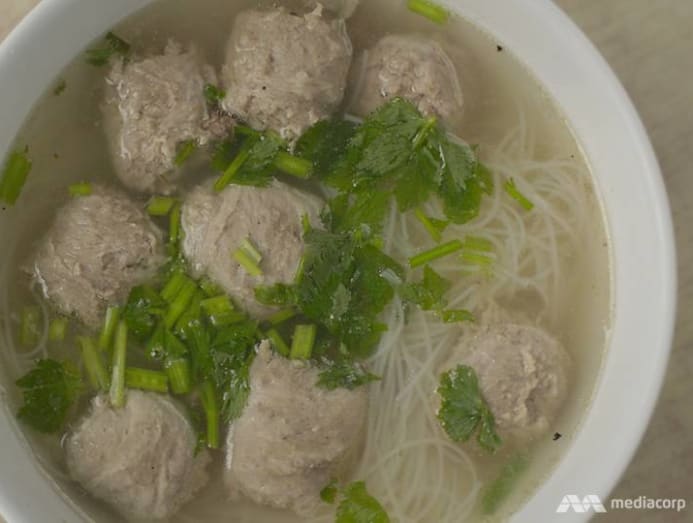
According to Brenda, her husband also learnt how to make the chilli sauce on that same trip back to China.
READ: Best eats: These UFO-shaped Fuzhou oyster cakes in Jalan Besar are out of this world
In its supporting role, the broth played up the deep flavour of the beef balls. It might have looked clear and plain, but it was far from bland. The water the beef balls had been soaking in was put to good use, boiled up with a little salt and meat bones for five hours to extract maximum meatiness.
Sipping carefully on the hot soup, it felt like a steamy spa for my senses. It was full-bodied in taste and aroma, yet felt very clean and nourishing. Slurping up the slippery bee hoon added another textural layer and a bit more bulk to the virtuous bowl of food.
The Beef House’s signature beef balls and noodle soup was truly satisfying and healthy, without the usual gut-busting after-effects of a hearty meal. However, for hungrier days, I recommend the works. Get the sliced beef dry noodle set (S$4 to S$6), choose bee hoon, kway teow or Hakka egg noodles tossed in lard and topped with fatty minced pork, plus an extra side of beef ball or beef tendon ball soup (S$4 or S$5).
True to a sign on its glass display, The Beef House does indeed serve up the nostalgic taste of Hakka beef balls from the 1950s to the 1970s. This humble stall absolutely delivers the long-lost flavours of a bygone era so many diners hanker after.
READ: Best eats: This satay bee hoon in Bukit Timah is a taste of Teochew history
“Some overseas customers from China who try our beef balls for the first time end up coming back every day for more. I think it’s difficult even for them to find these traditional flavours back home,” said Brenda.
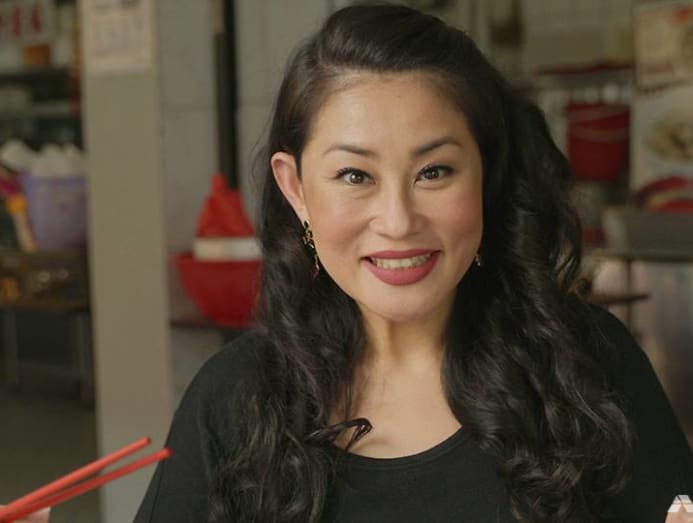
So should we worry that this Hakka culinary heritage seems to be on the wane? The Beef House’s success may have been built on an heirloom recipe brought to Singapore from China many decades ago, but theirs is not a vanishing trade just yet. Not whilst the hardworking second and third generations of this culinary family are still around.
Better yet, of their three children, Brenda and Chin’s youngest son has expressed a keen interest in the family business, so rest assured that a bright and bouncy future is in store for this unique style of traditional Hakka beef balls. It’s a legacy worth preserving into the fourth generation and beyond.
The Beef House Hakka Beef Balls is located at Gar Lok Eating House, 217 Syed Alwi Rd, Singapore 207776. It’s open from 8am to 5pm, Saturdays to Thursdays (closed on Fridays). Catch Makan Kakis with Denise Tan every Thursday from 11am on GOLD 905.





